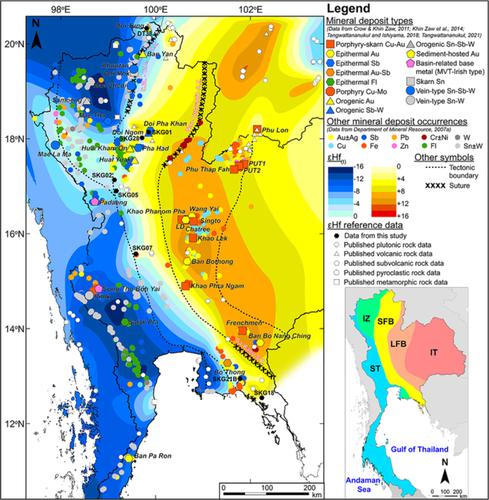当前位置:
X-MOL 学术
›
Resour. Geol.
›
论文详情
Our official English website, www.x-mol.net, welcomes your
feedback! (Note: you will need to create a separate account there.)
Zircon Hf-isotope constraints on the formation of metallic mineral deposits in Thailand
Resource Geology ( IF 1.1 ) Pub Date : 2021-07-30 , DOI: 10.1111/rge.12276 Apivut Veeravinantanakul 1 , Ryohei Takahashi 1 , Andrea Agangi 1 , Tsukasa Ohba 1 , Yasushi Watanabe 1 , Marlina A. Elburg 2 , Henriette Ueckermann 2 , Pitsanupong Kanjanapayont 3, 4 , Punya Charusiri 3, 5
Resource Geology ( IF 1.1 ) Pub Date : 2021-07-30 , DOI: 10.1111/rge.12276 Apivut Veeravinantanakul 1 , Ryohei Takahashi 1 , Andrea Agangi 1 , Tsukasa Ohba 1 , Yasushi Watanabe 1 , Marlina A. Elburg 2 , Henriette Ueckermann 2 , Pitsanupong Kanjanapayont 3, 4 , Punya Charusiri 3, 5
Affiliation

|
The effects of the Sibumasu–Indochina Terranes collision created several kinds of mineral deposits in Thailand, which include porphyry–skarn copper–gold, epithermal gold and antimony, orogenic gold–antimony–tungsten and tin-tungsten mineralization among others. The deposits show a distinct spatial zonal distribution and occur in specific tectonic terranes. Combining regional geological data and ore deposit distribution data with Hf-isotopic data of zircons in igneous rocks can be used to investigate the relationship between crustal construction processes and metallogeny. In this study, we investigated the Sukhothai Fold Belt, which is composed of quartz monzodiorite, granodiorite, syenogranite, and monzogranite of I- and S-type affinities. All granitoids were analyzed for zircon U–Pb geochronology and Lu–Hf isotopic analysis. The granitoids of the Sukhothai Fold Belt yielded U–Pb zircon ages ranging from ~243 to 202 Ma, which mark the timing of subduction to the syn-collisional stage between the Sibumasu–Indochina terranes at ~243–237 Ma and the timing of post-collision between the Sibumasu–Indochina terranes during 230–202 Ma. In addition, an age of ~43 Ma in the south of the Sukhothai Fold Belt may indicate intrusion during the sinistral movement of the Klaeng and Mae Ping fault zones resulted from the Indian–Eurasian plate collision. The Doi Tung quartz monzodiorite provided an age of ~350 Ma as a timing of formation of the Sukhothai Fold Belt. The negative and positive initial εHf values (−8.0 to +9.2) with two-stage depleted mantle model ages (TDMC of 2.2–0.6 Ga) of zircons from the Sukhothai Fold Belt granitoids indicate that the sources of their magma derived from partial melting of old continental crust and young oceanic crust, which probably mixed with a mantle-derived magma. A zircon Hf-isotope compilation including the data obtained in this study and previously reported values was used to prepare a map that allows a comparison between magmatic source and mineral deposit distribution in Thailand. The spatial distribution of Hf isotopic data reveals a distinct zonation, with initial εHf values decreasing from the east to the west, that is, from the western margin of the Indochina Terrane or the Loei Fold Belt to the Sukhothai Fold Belt, the Inthanon Zone and the Sibumasu Terrane. The magmatic source for the granitoids in the Loei Fold Belt is dominated by mantle-derived components, as shown by positive average initial εHf values (+1.0 to +12.7), and contributed to porphyry-related skarn copper–gold and iron and epithermal gold mineralization. In contrast, magmas in the Sibumasu Terrane and the Inthanon Zone originated from melting of old crustal materials, as indicated by mostly negative average initial εHf values (−15.1 to +0.8), and are responsible for S-type granite-related tin-tungsten mineralization. The average initial εHf values (−5.0 to +11.0) from the intrusions in the Sukhothai Fold Belt suggest mixed sources, including evolved and juvenile magmatic materials, which generated the orogenic gold deposits and other vein-type antimony, tungsten, fluorite, and base metal deposits. These results imply a close spatial correlation between the source of magmatism in each tectonic terrane of Thailand and different metal ore deposits. These isotope maps can be used as a powerful tool in the exploration for various commodities at the regional scale.
中文翻译:

锆石 Hf 同位素对泰国金属矿床形成的限制
Sibumasu-Indochina Terranes 碰撞的影响在泰国创造了几种矿床,包括斑岩-矽卡岩-铜-金、浅成热液金和锑、造山金-锑-钨和锡-钨矿化等。沉积物显示出明显的空间带状分布,并出现在特定的构造地体中。结合区域地质资料和矿床分布资料,结合火成岩中锆石的Hf同位素资料,可以研究地壳构造过程与成矿关系。在这项研究中,我们调查了素可泰褶皱带,它由石英二长闪长岩、花岗闪长岩、正长花岗岩和 I 型和 S 型亲和性二长花岗岩组成。对所有花岗岩进行了锆石 U-Pb 年代学和 Lu-Hf 同位素分析。素可泰褶皱带的花岗岩产生的 U-Pb 锆石年龄范围为~243 至 202 Ma,这标志着 Sibumasu-Indochina 地体在~243-237 Ma 之间俯冲到同碰撞阶段的时间和后时间- 230-202 Ma 期间 Sibumasu-Indochina 地体之间的碰撞。此外,素可泰褶皱带南部约 43 Ma 的年龄可能表明印度 - 欧亚板块碰撞导致 Klaeng 和 Mae Ping 断裂带向左运动期间的侵入。Doi Tung 石英二长闪长岩提供了约 350 Ma 的年龄作为 Sukhothai 褶皱带形成的时间。两阶段耗尽地幔模型年龄(T 这标志着 Sibumasu-Indochina 地体之间在~243-237 Ma 之间的同碰撞阶段的俯冲时间和 Sibumasu-Indochina 地体之间在 230-202 Ma 期间的后碰撞时间。此外,素可泰褶皱带南部约 43 Ma 的年龄可能表明印度 - 欧亚板块碰撞导致 Klaeng 和 Mae Ping 断裂带向左运动期间的侵入。Doi Tung 石英二长闪长岩提供了约 350 Ma 的年龄作为 Sukhothai 褶皱带形成的时间。两阶段耗尽地幔模型年龄(T 这标志着 Sibumasu-Indochina 地体之间在~243-237 Ma 之间的同碰撞阶段的俯冲时间和 Sibumasu-Indochina 地体之间在 230-202 Ma 期间的后碰撞时间。此外,素可泰褶皱带南部约 43 Ma 的年龄可能表明印度 - 欧亚板块碰撞导致 Klaeng 和 Mae Ping 断裂带向左运动期间的侵入。Doi Tung 石英二长闪长岩提供了约 350 Ma 的年龄作为 Sukhothai 褶皱带形成的时间。两阶段耗尽地幔模型年龄(T 素可泰褶皱带南部约 43 Ma 的年龄可能表明印度 - 欧亚板块碰撞导致 Klaeng 和 Mae Ping 断裂带向左运动期间的侵入。Doi Tung 石英二长闪长岩提供了约 350 Ma 的年龄作为 Sukhothai 褶皱带形成的时间。两阶段耗尽地幔模型年龄(T 素可泰褶皱带南部约 43 Ma 的年龄可能表明印度 - 欧亚板块碰撞导致 Klaeng 和 Mae Ping 断裂带向左运动期间的侵入。Doi Tung 石英二长闪长岩提供了约 350 Ma 的年龄作为 Sukhothai 褶皱带形成的时间。两阶段耗尽地幔模型年龄(TDM ç2.2-0.6 Ga) 的素可泰褶皱带花岗岩中的锆石表明它们的岩浆来源来自古老的大陆地壳和年轻的洋壳的部分熔融,可能与地幔来源的岩浆混合。包括本研究中获得的数据和先前报告的值在内的锆石 Hf 同位素汇编被用来准备一张地图,该地图可以比较泰国的岩浆源和矿床分布。Hf同位素数据的空间分布显示出明显的分带,初始εHf值自东向西递减,即从印度支那地体或黎族褶皱带的西缘到素可泰褶皱带、因他侬带和Sibumasu Terrane。黎族褶皱带花岗岩的岩浆源以地幔成分为主,如正平均初始 εHf 值(+1.0 至 +12.7)所示,并有助于与斑岩相关的矽卡岩铜-金和铁以及浅成热液金矿化。相比之下,Sibumasu Terrane 和 Inthanon 带中的岩浆起源于旧地壳物质的熔化,如大多数负平均初始 εHf 值(-15.1 至 +0.8)所示,并且是 S 型花岗岩相关锡钨的原因矿化。素可泰褶皱带侵入体的平均初始 εHf 值(-5.0 至 +11.0)表明混合来源,包括演化和新生岩浆材料,它们产生了造山金矿床和其他脉状锑、钨、萤石和基底金属沉积物。这些结果意味着泰国每个构造地体的岩浆源与不同金属矿床之间存在密切的空间相关性。这些同位素图可用作在区域范围内勘探各种商品的有力工具。
更新日期:2021-09-27
中文翻译:

锆石 Hf 同位素对泰国金属矿床形成的限制
Sibumasu-Indochina Terranes 碰撞的影响在泰国创造了几种矿床,包括斑岩-矽卡岩-铜-金、浅成热液金和锑、造山金-锑-钨和锡-钨矿化等。沉积物显示出明显的空间带状分布,并出现在特定的构造地体中。结合区域地质资料和矿床分布资料,结合火成岩中锆石的Hf同位素资料,可以研究地壳构造过程与成矿关系。在这项研究中,我们调查了素可泰褶皱带,它由石英二长闪长岩、花岗闪长岩、正长花岗岩和 I 型和 S 型亲和性二长花岗岩组成。对所有花岗岩进行了锆石 U-Pb 年代学和 Lu-Hf 同位素分析。素可泰褶皱带的花岗岩产生的 U-Pb 锆石年龄范围为~243 至 202 Ma,这标志着 Sibumasu-Indochina 地体在~243-237 Ma 之间俯冲到同碰撞阶段的时间和后时间- 230-202 Ma 期间 Sibumasu-Indochina 地体之间的碰撞。此外,素可泰褶皱带南部约 43 Ma 的年龄可能表明印度 - 欧亚板块碰撞导致 Klaeng 和 Mae Ping 断裂带向左运动期间的侵入。Doi Tung 石英二长闪长岩提供了约 350 Ma 的年龄作为 Sukhothai 褶皱带形成的时间。两阶段耗尽地幔模型年龄(T 这标志着 Sibumasu-Indochina 地体之间在~243-237 Ma 之间的同碰撞阶段的俯冲时间和 Sibumasu-Indochina 地体之间在 230-202 Ma 期间的后碰撞时间。此外,素可泰褶皱带南部约 43 Ma 的年龄可能表明印度 - 欧亚板块碰撞导致 Klaeng 和 Mae Ping 断裂带向左运动期间的侵入。Doi Tung 石英二长闪长岩提供了约 350 Ma 的年龄作为 Sukhothai 褶皱带形成的时间。两阶段耗尽地幔模型年龄(T 这标志着 Sibumasu-Indochina 地体之间在~243-237 Ma 之间的同碰撞阶段的俯冲时间和 Sibumasu-Indochina 地体之间在 230-202 Ma 期间的后碰撞时间。此外,素可泰褶皱带南部约 43 Ma 的年龄可能表明印度 - 欧亚板块碰撞导致 Klaeng 和 Mae Ping 断裂带向左运动期间的侵入。Doi Tung 石英二长闪长岩提供了约 350 Ma 的年龄作为 Sukhothai 褶皱带形成的时间。两阶段耗尽地幔模型年龄(T 素可泰褶皱带南部约 43 Ma 的年龄可能表明印度 - 欧亚板块碰撞导致 Klaeng 和 Mae Ping 断裂带向左运动期间的侵入。Doi Tung 石英二长闪长岩提供了约 350 Ma 的年龄作为 Sukhothai 褶皱带形成的时间。两阶段耗尽地幔模型年龄(T 素可泰褶皱带南部约 43 Ma 的年龄可能表明印度 - 欧亚板块碰撞导致 Klaeng 和 Mae Ping 断裂带向左运动期间的侵入。Doi Tung 石英二长闪长岩提供了约 350 Ma 的年龄作为 Sukhothai 褶皱带形成的时间。两阶段耗尽地幔模型年龄(TDM ç2.2-0.6 Ga) 的素可泰褶皱带花岗岩中的锆石表明它们的岩浆来源来自古老的大陆地壳和年轻的洋壳的部分熔融,可能与地幔来源的岩浆混合。包括本研究中获得的数据和先前报告的值在内的锆石 Hf 同位素汇编被用来准备一张地图,该地图可以比较泰国的岩浆源和矿床分布。Hf同位素数据的空间分布显示出明显的分带,初始εHf值自东向西递减,即从印度支那地体或黎族褶皱带的西缘到素可泰褶皱带、因他侬带和Sibumasu Terrane。黎族褶皱带花岗岩的岩浆源以地幔成分为主,如正平均初始 εHf 值(+1.0 至 +12.7)所示,并有助于与斑岩相关的矽卡岩铜-金和铁以及浅成热液金矿化。相比之下,Sibumasu Terrane 和 Inthanon 带中的岩浆起源于旧地壳物质的熔化,如大多数负平均初始 εHf 值(-15.1 至 +0.8)所示,并且是 S 型花岗岩相关锡钨的原因矿化。素可泰褶皱带侵入体的平均初始 εHf 值(-5.0 至 +11.0)表明混合来源,包括演化和新生岩浆材料,它们产生了造山金矿床和其他脉状锑、钨、萤石和基底金属沉积物。这些结果意味着泰国每个构造地体的岩浆源与不同金属矿床之间存在密切的空间相关性。这些同位素图可用作在区域范围内勘探各种商品的有力工具。









































 京公网安备 11010802027423号
京公网安备 11010802027423号